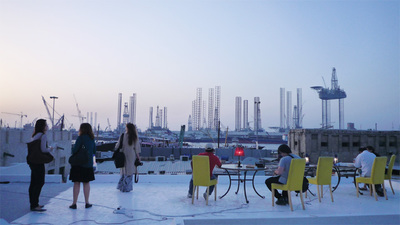Mumbai’s Polymaths
Shaina Anand and Ashok Sukumaran’s radio broadcasting project,
Radio Meena, at 2009 Sharjah Biennial. Courtesy CAMP, Mumbai.
All artists define themselves however they wish—it is an appealing built-in feature of the profession. In Mumbai (formerly Bombay), a freewheeling redefinition of artistic practice is taking shape in the work of a multi-talented husband-and-wife duo.Shaina Anand received her MFA in film and media arts from Temple University, and Ashok Sukumaran received his MFA in design media arts from UCLA. Their interests intersect and diverge, almost always exploding beyond traditional artistic boundaries.
The collaborating artists are aesthetically sensitive polymaths, with expertise spanning communications technology to documentary filmmaking, and a commitment to localized political action and social practice. Common threads of ethics, community-building, and technological innovation are woven throughout their production.
Most of Anand and Sukumaran’s projects stretch our thinking about what constitutes art, which for them is probably beside the point. Yet working under the umbrella of art allows them great liberty, affording funding sources, outlets for further exposure, and professional validation. They are key members of two ongoing group initiatives: CAMP, an organization they founded in 2007 with Sanjay Banghar, which generates events and projects from a retrofitted work space in the residential Bombay neighborhood of Bandra; and Pad.ma (Public Access Digital Media Archive), begun by a handful of organizations in Mumbai, Bangalore, and Berlin.
Right away you reach unfamiliar terrain when you land on the beautiful CAMP home page (www.camputer.org), which makes no mention of artworks or exhibitions. Venture deeper, you’ll find that the group considers thresholds of ownership and authority as challenging sites for art practice. Rather than working with sculpture or painting, by far the preferred modes of practice in Mumbai, CAMP’s favored media are infrastructures like electricity, transport, trade, archives, video, radio, and the Internet. Distribution platforms and collective networks play a part in most of their projects.
Their work appears in many contexts, including a narrated rooftop open-air film screening at CAMP’s rooftop office, a multi-media museum installation about free trade routes operating outside WTO jurisdiction in the Arabian Sea (the Boat Modes project), a black-box video projection on the same topic at dOCUMENTA (13) in Kassel, and a work shown recently at the New Museum, New York, that invited viewers to listen to and read the subtitles of secretly taped and leaked telephone conversations exposing corruption at the highest levels of Indian business and government.
I have read about projects I wish I had witnessed firsthand: Ashok Sukumaran’s piece that cobbled together a continuous string of lights in a Mumbai neighborhood, uniting many different, alienated local constituencies, that then invited everyone to hand-crank the electrical current to light up their (now) communal night. There is also Radio Meena, which invited marine traders to upload songs and participate in an open radio station broadcast at the local wharf four nights during the Sharjah Biennale. One subject rolls into the next, with iterations adapted to fit the immediate context.
CAMP encourages many kinds of actions, but these creative partners’ involvement with Pad.ma is more focused. Pad.ma is an elaborate software and database archive making moving image footage available online for non-commercial use, and allowing users to type their own text annotations. The archive accrues with each layer indexed to its subject, accumulating archaeologically aggregated layers. In its essence, Pad.ma embodies a strong political statement about open source data, refreshingly devoid of self-important blather.
All projects of Shaina and Ashok deal with interesting topics in and of themselves, often providing new information culled from primary research, sharing resources, and building networks. They take on added relevance in a city like Mumbai, where infrastructure is ad hoc, organized from the ground up rather than the top down; where the chasm between the haves and the have-nots couldn’t be greater; and where technology is embraced, if not always cutting edge. The practice of these artists speaks fluently in the languages of global contemporary art, and is quite anomalous within their local art scene. Yet it is extremely rooted, providing new models that invite collaboration and participation at every turn.
_____________________________________________________________________________________
Susan Hapgood is founding director of the Mumbai Art Room, Mumbai, and senior advisor of ICI (Independent Curators International), New York.

